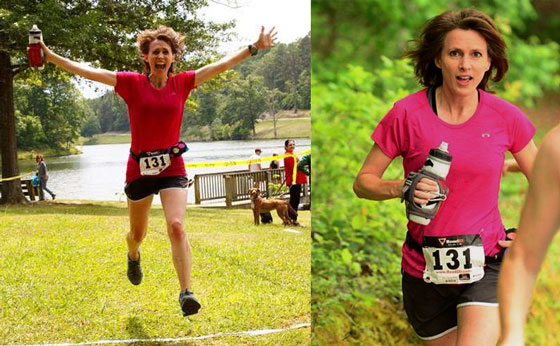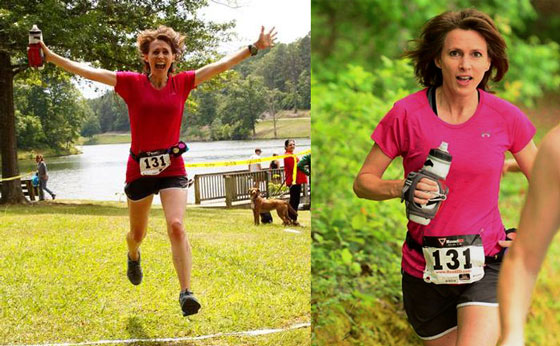
Last year, Gail Nestor set a personal goal for herself: To finish the AJC Peachtree Road Race in under an hour.
The challenge seemed simple enough, and with 18 previous races under her belt, she felt almost certain she would accomplish her goal.
But something went wrong.
In the second half of the race, Nestor, 44, found herself battling symptoms of heat exhaustion.
“It just felt like the world was graying in on its edges,” recalls Nestor, a Smyrna resident who had been running the race every Fourth of July for years and had never before experienced heat illness.
Last year’s combination of heat and hills in the second half of the race proved to be too much for the veteran racer, and after experiencing mild dizziness, headaches and virtual exhaustion, Nestor decided to quit running the race and walk.
“It gets to the point where you realize it’s not good to keep running,” says Nestor, who nevertheless finished just shy of her goal, with a final time of 1:02:57.
One of the biggest issues facing Peachtree Road Race participants is that most aren’t accustomed to running such a distance under such difficult environmental conditions, says Dr. Bud Cooper, a certified strength and condition specialist and a former chief athletic trainer for the race.
The annual race is an Independence Day tradition and the biggest 10K in the nation. This year, as is typical, it will draw 60,000 participants from near and far — ranging from world-famous runners to highly conditioned amateurs to people who are testing their limits for the first time.
The temperatures for Wednesday’s race are expected to be somewhat cooler than the sweltering heat of the weekend, which brought the highest thermometer reading in Atlanta history and caused the worst air quality in almost five years. Still, the heat and humidity are likely to be considerable, and may overpower some runners. Last year, the start-time temperature was in the mid-70s.
After registering to take part, runners are placed in start waves for the morning of the race. Depending on the wave a runner qualifies for, he or she could be crossing the start line at any time between 7 a.m. and 9:05 a.m. –- and that time difference makes a huge difference in the kinds of temperatures that runners will experience.
For runners approaching the later, more challenging part of the race, including the infamous “Cardiac Hill,” the time difference can mean some will have to deal with weather 10 to 15 degrees hotter than others face.
Know the danger signals
It’s no secret that Georgia can get very hot in July. In most everyday situations, that simply means greater discomfort. But runners who are not acclimated to the sweltering conditions are taking a huge risk for exertional heat illnesses, especially if they are running something as long as a 10K.
Although Nestor didn’t seek immediate medical attention during last year’s race, her experience that day suggests a case of exertional heat exhaustion, with symptoms that can include loss of coordination, dizziness or fainting, dehydration, profuse sweating or pale skin, headache and nausea.
Heat exhaustion is actually a relatively mild form of heat illness. It should serve as a caution for athletes to take heed before experiencing a more severe form — exertional heat stroke –- a condition in which the body’s core temperature soars above 104 degrees.
At such an elevated temperature, essentially a raging fever, the body’s central nervous system goes into dysfunction, and tissue in vital organs can be permanently damaged.
While there are five categories of heat illness in all, heat stroke is an immediate medical emergency. It’s a matter of life and death.
The bottom line is you cannot go out and run a 10K if you are not properly prepared, says Cooper, who’s associate department head of the Exercise Science Program at the University of Georgia.
But when it comes to preparing for such a fun and popular race, some runners don’t really factor in the impact of heat. They’re more focused on making memories with friends, tackling new fitness goals or just enjoying themselves.
“Overall, I want to just go out, run a good race, and have fun,” says Tonya Baker, 33, a UGA graduate student who this year will be running her second Peachtree.
“When I decided that I wanted to be a runner, I just went out for a run,” says Baker, who will be running the race with her fiancé as they work to achieve fitness goals together.
To prepare for this year’s race, Baker casually ran with an evening running group twice a week, and on her own twice a week as well. “I’d be lying if I said that I did a formal preparation program,” says Baker, who plans to “use sunblock, stay hydrated, and wear light-colored clothing” to prevent overheating.
Baker falls into the large category that Cooper calls “recreational runners,” those who run or train sporadically and participate in only one or two races a year. Cooper estimates that they make up anywhere from one-third to one-half of all Peachtree runners annually, and are also the ones most at risk of experiencing heat illness.
Conditioning is important
Up until last year, Nestor might have fit into the recreational category as well. For two decades, it was her custom to begin training for the Peachtree two months in advance, and then, once it was over, to “lose all enthusiasm and not want to run for the rest of the year.”
But after her bout with heat illness last July Fourth, she decided to alter her regimen. For this year’s race, she trained throughout the year in order to be better prepared.
“This year, I set a goal to run one race per month all year,” Nestor says.
In just one year, she has increased her running average to 50 to 60 miles per week and has incorporated more hills and heat into her training regimen to prepare for the Peachtree.
“I know much better how to pace myself and I am a lot stronger,” says Nestor, who finished her most recent 10K in just over 45 minutes and is more excited about her upcoming 20th Peachtree Road Race than about any before.
For the several thousand recreational racers like Baker who will be showing up on the Fourth to have a good race and a lot of fun, Cooper offers some precautionary advice: Get plenty of rest and hydrate properly the night before. On the morning of the race, wear light clothing, drink as you go, and don’t be afraid to stop and walk.
But most importantly, enjoy the race. “This is not the time to go out and set your personal record,” says Cooper.
Update on runners’ 2012 Peachtree experience:
During Wednesday’s race, Gail Nestor experienced a minor bout of heat exhaustion, but she was able to stop for a proper cool down and walk a little and still finish the race with a personal Peachtree record of 47:30 (7:38 pace), beating her time from last year by 15 minutes.
While Tonya Baker fell short of her initial goal of running at least one race per month to prepare for Wednesday’s race, she was able to squeeze in the HBCU Alumni 5K last weekend just in time to finish up her preparation for the Peachtree. On Wednesday, she set a personal record for completing a 10K, beat her Peachtree time for last year and was still able to squeeze in a little fun by stopping to do the Cupid Shuffle with the Bank of America cheer team.
Felicia Harris is an independent health reporter who lives in Athens, Ga. A recent graduate of the Health and Medical Journalism graduate program at the University of Georgia, her interest is in reporting on health disparities and health policy.

